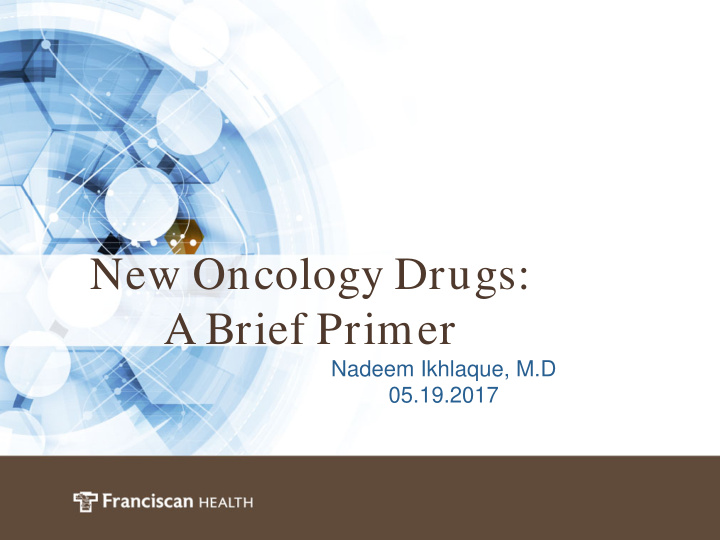



New Oncology Drugs: PowerPoint Cover Title A Brief Primer Nadeem Ikhlaque, M.D 05.19.2017 Subtitle Would Go Here
Learning Objectives • List novel chemotherapies and the indications of these newer agents • Recognize the disadvantages and challenges of traditional cancer treatment • Mechanism of monoclonal antibodies and associated toxicities (targeted therapies) • Explain how immunotherapy works, evolving indications and associated toxicities 2
How did we get here? • Evolution • Surgery • Radiation Therapy • Systemic Therapy 3
Cytotoxic Chemotherapy • Use of anti-cancer drugs to slow or stop the growth of rapidly dividing cancer cells. • Inhibiting different phases of the cell cycle, chemotherapy became an effective validity in cancer treatment • Challenge: associated toxicity involving normal cell functioning required for normal well being 4
Toxicities • GI toxicities • Bone Marrow suppression • Neurological toxicities • Cardiac dysfunction • Dermatological toxicities • Constitutional symptoms 5
A New Era of Cancer Treatment • Monoclonal antibodies • Oral molecular target drugs • Immunotherapy 6
Monoclonal Antibodies • Rituximab • CD20 Inhibitor. NHL • Bevacizumab • VEGF Blocker. GBM, NSLC, Colorectal cancers, Ovarian, cervical and RCC • Transtuzumab, Pertuzumab • Her-2 Blockade. Breast, Gastric cancer • Cetuximab • EGFR blocker, Head and Neck and Colorectal. • Panitumumab • EGFR blocker, Colorectal. • Ramucirumab • Vascular endothelial growth factor receptor 2 (VEGFR2). Lung, gastric and colorectal. 7
Monoclonal Antibodies Toxicity Allergic and Infusion reactions Hemorrhage Hypertension and Proteinuria Skin rash Nose bleed Delayed wound healing and wound dehiscence GI Perforation 8
Monoclonal Trastuzumab Antibodies Bevacizumab Cetuximab Panitumumab Tipifarnib Lonafarnib Lapatinib Erlotinib I matinib Sorafenib Small Molecule mTOR TKI s/ STI s Hudis CA. NEJM 2007;357(1):41
Oral Molecular Target Drugs • Imatinib, Nilotinib, Dasatinib • TKI. CML. BCR/ABL inhibitor • Sunitinib, Sorifinib, Pazopanib • Tyrosine Kinase Inhibitors. • RCC, HCC, STS • Erlotinib, Afatinib, Gefitinib, Osimertinib • EGFR blockers. NSLC • Lapatinib • Her 2 locker • Regorafenib • VEGF/TKI Blocker. CRC,GIST and HCC • Vemurafinib, Tirametinib • B-raf inhibitor, Malignant Melanoma 10
Toxicicty Fatigue Cytopenias Hypertension Cardiac dysfunction Liver dysfunction Thyroid dysfunction Skin Rash 11
Immune Checkpoint Inhibitors • Ipilimumab • Malignant Melanoma • Nivolumab • Malignant Melanoma, NSLC, RCC, Squamous cell cancer of head and neck, Classical Hodgkin’s lymphoma, Urothelial cancer,, • Pembrolizumab • Malignant Melanoma, NSLC,, Squamous cell cancer of head and neck, Classical Hodgkin’s lymphoma, • Atezolizumab • Urothelial carcinoma and NSLC. 13
Mechanism of Action 14
15
Cancer and Immune System • Interaction between cancer and the immune system plays a pivotal role in cancer development. • In cancer patients, the immune system is not sufficiently vigorous to eliminate cancer cells, suggesting that the antitumor immune system is suppressed. • For instance, transplant recipients under continued immunosuppression displayed a significantly higher risk of developing de novo tumors. • AIDS • Autoimmune Disorders 16
Cancer and Immune System 17
PD-1 • PROGRAMMED CELL DEATH PROTEIN 1 (PD-1) Immunosuppressive molecule that is expressed on T-cells • Activated when it binds to its ligand (PDL-1) • Activation leads to impaired T-cell function 18
PD-1 • PROGRAM CELL DEATH LIGAND 1 (PDL-1) • Ligand that binds to and activates PD-1 • PDL-1 is expressed on many cancer cells 19
PD-1 20
PD-1 21
PD-1 22
Toxicities • Colitis • Hepatitis • Endocrinopathies • Pneumonitis • Nephritis/Renal dysfunction • Dermatitis 23
Conclusion • Cancer treatment Paradigm is rapidly changing. • Monoclonal Antibodies and Targeted therapies allow selective action to attack cancer cells mainly and reduce risks of traditional toxicities • Immunotherapy is a novel but old concept in cancer treatment which recently changed the practice standards in several cancers. 24
Conclusion • Durable response to treatment and long term treatment plans. • Compliance issues with oral treatments. • False impression of being cured from advance malignancy and tendency to stop treatment. • Immunogenic side affects and role of high dose prednisone to counteract. 25
References Hudis CA. NEJM 2007;357(1):41 Keir, Annu Rev Immuncl. 2008 26:677-704 Thompson, RH, et. Al PNAS 2004, 101: 17174-17179 26
Recommend
More recommend